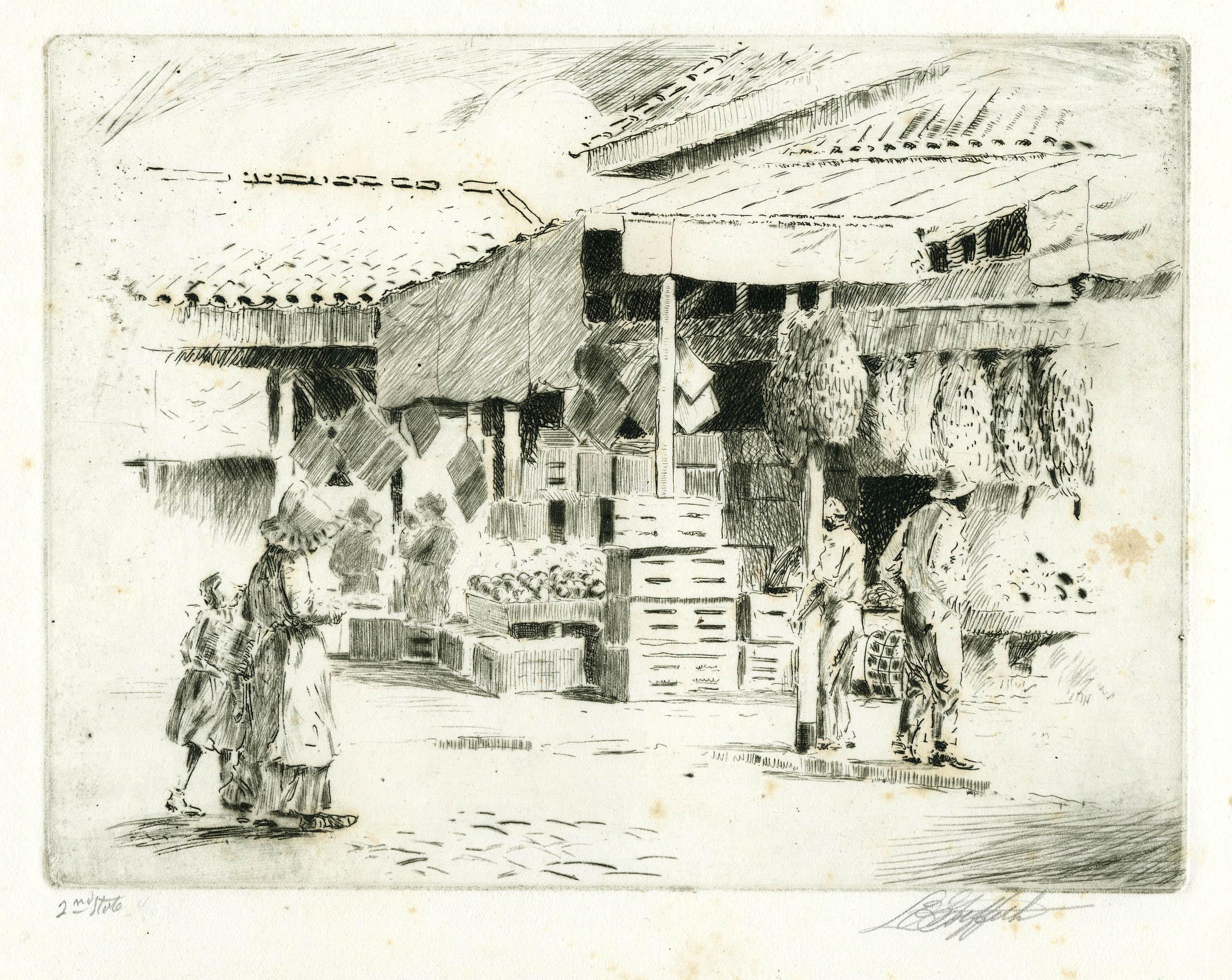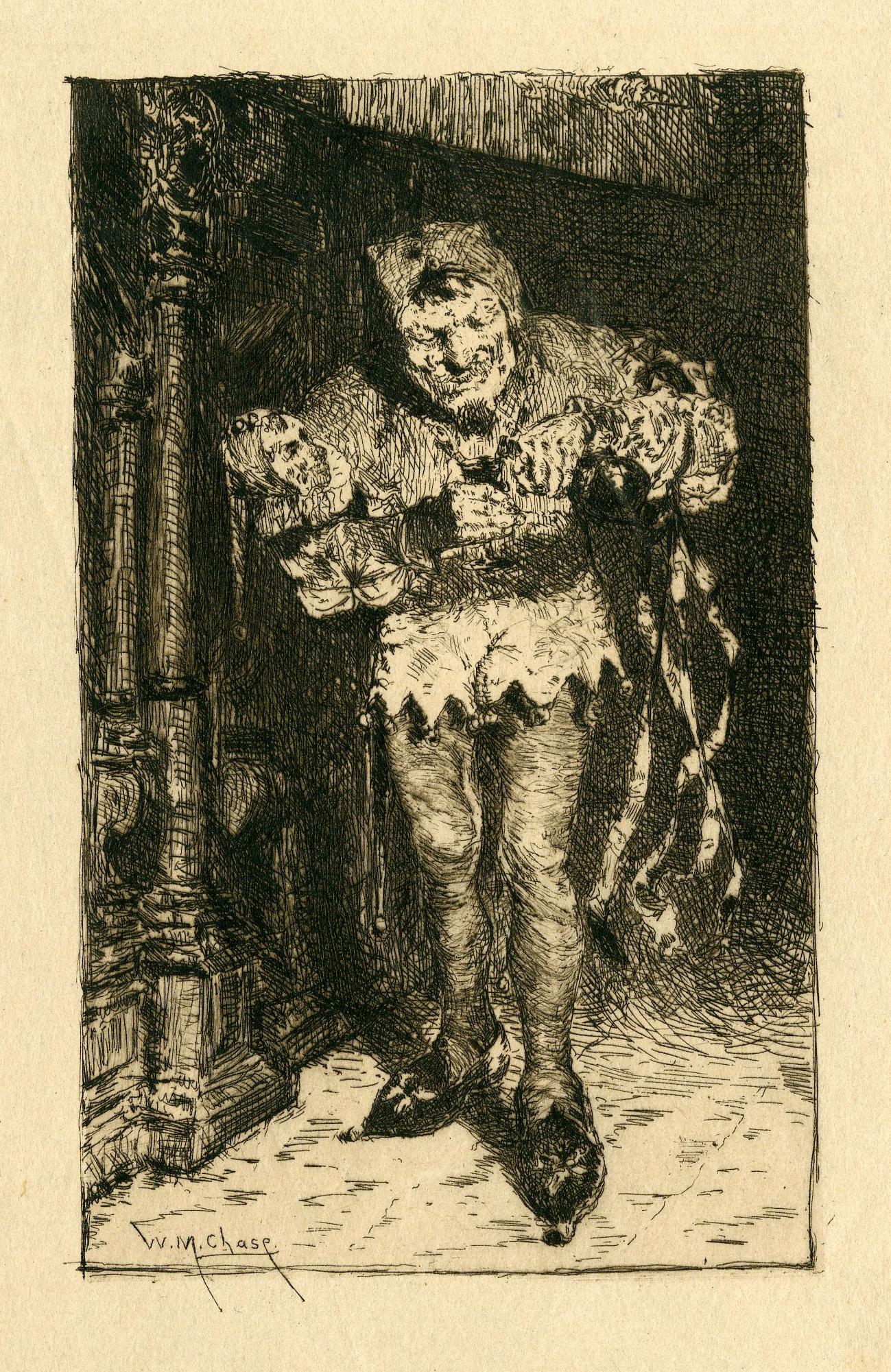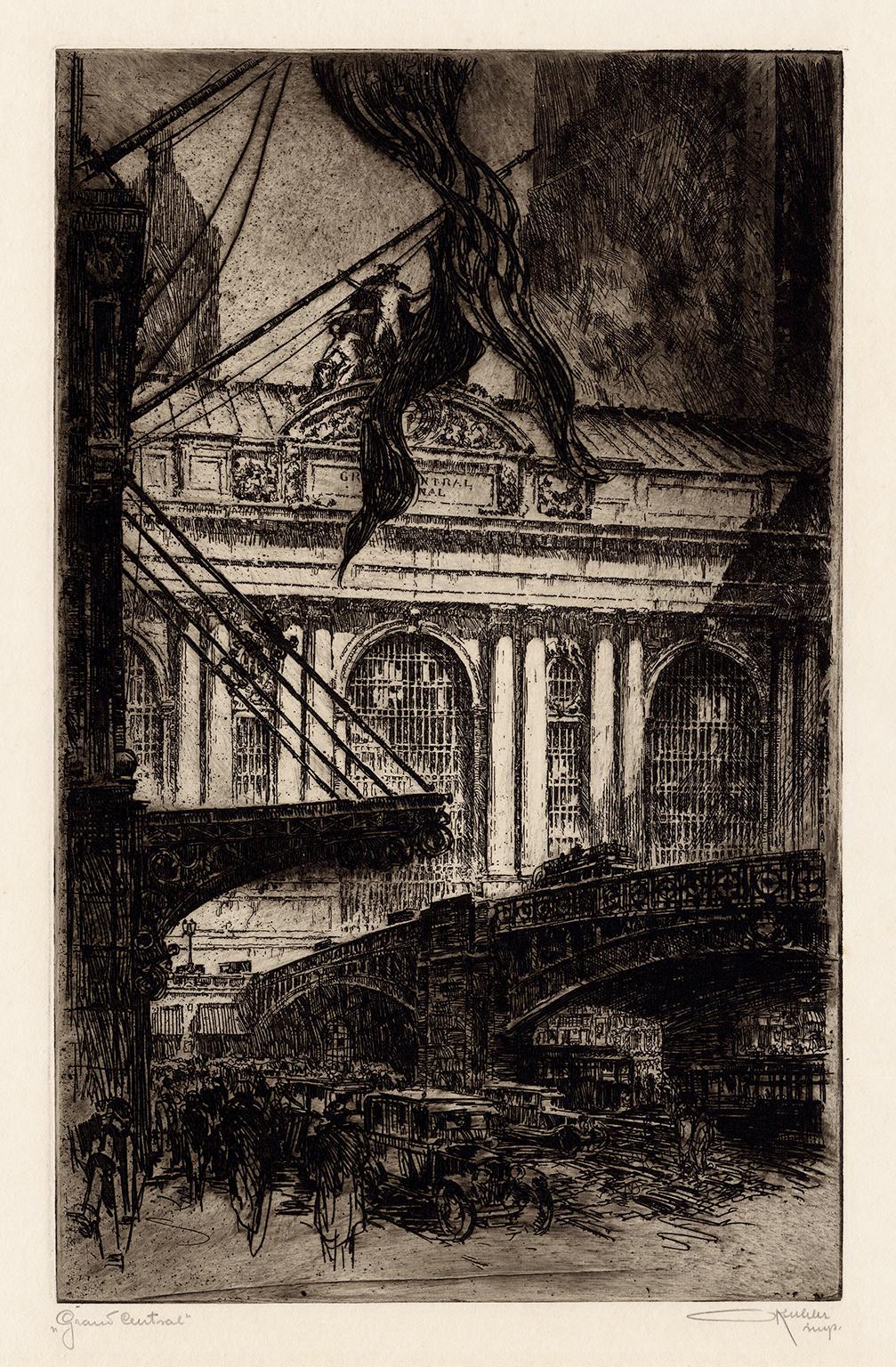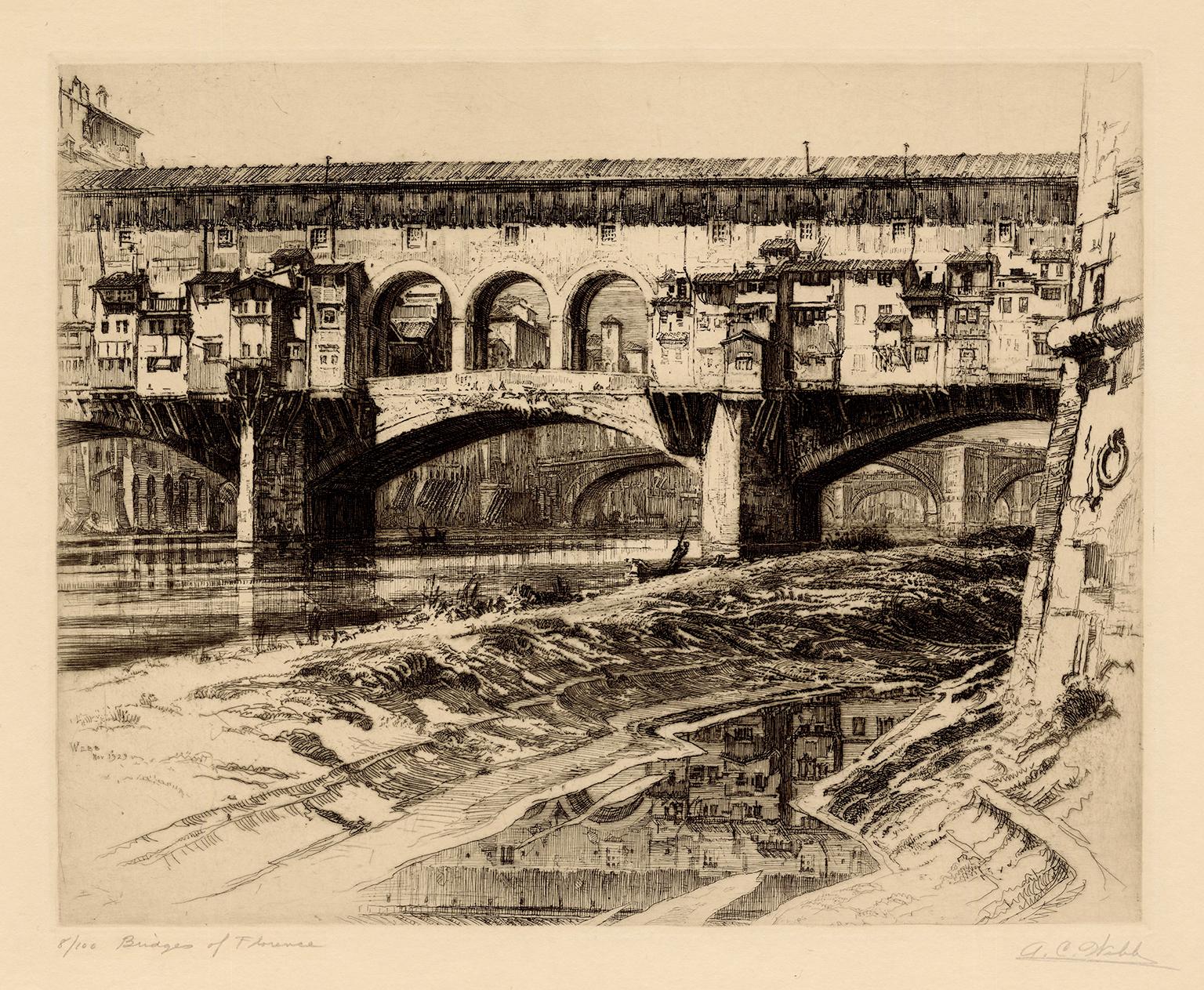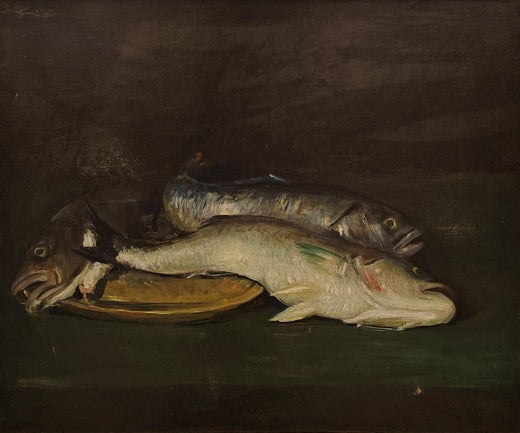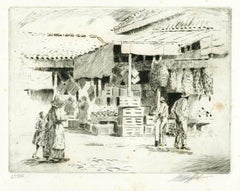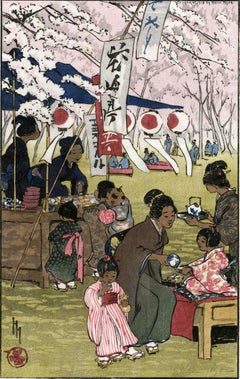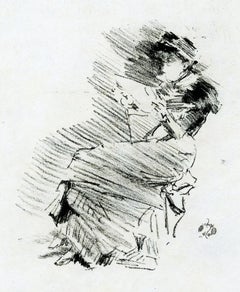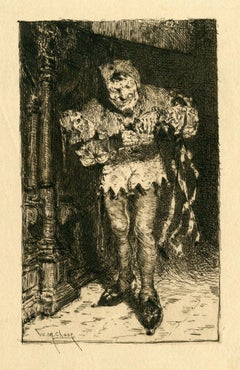
Keying Up - The Court Jester
View Similar Items
Want more images or videos?
Request additional images or videos from the seller
1 of 10
William Merritt ChaseKeying Up - The Court Jester1879
1879
$1,200List Price
About the Item
- Creator:William Merritt Chase (1849-1916, American)
- Creation Year:1879
- Dimensions:Height: 6.63 in (16.85 cm)Width: 4.25 in (10.8 cm)
- Medium:
- Movement & Style:
- Period:
- Condition:
- Gallery Location:Fairlawn, OH
- Reference Number:Seller: FA53381stDibs: LU1409490252
William Merritt Chase
William Merritt Chase rejected his father’s shoe business in favor of studying art professionally, training with Barton S. Hayes in Indianapolis and going abroad to the Royal Academy in Munich. His brushwork and use of light was similar to the French Impressionists, and his style of visual modelling was particularly influenced by Eduoard Manet. After he finished his studies Chase travelled to New York City and began teaching as part of the Art Students League, quickly becoming a renowned teacher. He incorporated Impressionist techniques along with his more traditional European education to create unique images imbued with the valued urbanization and expansion of New York City. Later in his life, Chase established the Chase School, which eventually was renamed the Parsons School of Design.
About the Seller
5.0
Recognized Seller
These prestigious sellers are industry leaders and represent the highest echelon for item quality and design.
Gold Seller
Premium sellers maintaining a 4.3+ rating and 24-hour response times
Established in 1978
1stDibs seller since 2013
796 sales on 1stDibs
Typical response time: 1 hour
Associations
International Fine Print Dealers Association
Authenticity Guarantee
In the unlikely event there’s an issue with an item’s authenticity, contact us within 1 year for a full refund. DetailsMoney-Back Guarantee
If your item is not as described, is damaged in transit, or does not arrive, contact us within 7 days for a full refund. Details24-Hour Cancellation
You have a 24-hour grace period in which to reconsider your purchase, with no questions asked.Vetted Professional Sellers
Our world-class sellers must adhere to strict standards for service and quality, maintaining the integrity of our listings.Price-Match Guarantee
If you find that a seller listed the same item for a lower price elsewhere, we’ll match it.Trusted Global Delivery
Our best-in-class carrier network provides specialized shipping options worldwide, including custom delivery.More From This Seller
View AllNoon Time Lull (Charleston, South Carolina)
By Louis Oscar Griffith
Located in Fairlawn, OH
Noon Time Lull (Charleston, South Carolina)
Etching, c. 1930
Signed by the artist in pencil lower right (see photo)
Note: An image done in South Carolina.
An impression of this image...
Category
1930s American Impressionist Figurative Prints
Materials
Etching
Keying Up - The Court Jester
By William Merritt Chase
Located in Fairlawn, OH
Keying Up - The Court Jester
Etching with drypoint, 1879
Signed in the plate lower left corner (see photos)
Proof before engraved title and engraved names
Printed on thin light golden Japanese tissue paper
In the final state, with engraved titled and typeface engraved artist’s signature below the image
Condition: excellent
Plate size: 6-5/8 x 4-1/4"
According to Pisano, this image was very popular during Chase’s life. It is based on his famous painting, Keying Up-The Court Jester, in the collection of the Pennsylvania Academy of Fine Arts. The painting was created in Munich during the artist’s studies there. It was exhibited in the 1876 Centennial Exhibition in Philadelphia where it won a Medal of Honor and helped establish the artist’s reputation as a leading American painter.
Chase, always conscious of self promotion, created the etching and had numerous impressions printed. He sold them for a modest price to increase his fame. The etching was later published in Sylvester R. Koehler, American Art Review, September 1878. It was for this American Art Review printing that the engraved titled and type face signature below the image were added to the plate.
This example was part of a group of impressions that came down in the Chase family via his daughter Dorothy Bremond Chase, his third daughter. They were acquired at auction in a single auction lot, housed in a paper board folder. The consignor was Associated American Artist’s as they were liquidating their stock prior to closing the gallery.
Dorothy was the subject of Chase’s painting, My Little Daughter Dorothy. C. 1894, in the collection of the Detroit Institute of Arts as well as numerous other portraits of her.
Reference: Pisano/Bake, Volume 1, Pr. 3, illustrates the rare 1st state, this being a 2nd state before any other the engraved title and Chase's name in the bottom margin which are found in the third state.
Artist bio in file (Chase)
In 1883 Chase was involved in the organization of an exhibition to help raise funds for a pedestal for the Statute of Liberty. The exhibition featured loans of three works by Manet and urban scenes by the Italian Impressionist Giuseppe de Nittis. Both artists influenced Chase's Impressionistic style that gave rise to a series of New York park scenes. It is also thought that he was influenced by John Singer Sargent's In the Luxembourg Gardens (1879) which was exhibited in New York at this time. Indeed, Chase had met Sargent in Europe in 1881, the two men becoming lifelong friends with Sargent painting Chase's portrait in 1902.
On another European trip in 1885, Chase met James McNeill Whistler in London. While Whistler had a reputation for being difficult, the two artists got along famously and agreed to paint one another's portrait. Eventually, however, Whistler's moods began to grate with Chase who wrote home stating "I really begin to feel that I never will get away from here". For his part, Whistler criticized Chase's finished portrait and, according to Hirshler, "complained about Chase for the rest of his life". While no record exists of Whistler's portrait of Chase; Chase's portrait of Whistler remains a well-known piece in his oeuvre.
In 1887 Chase married Alice Gerson, the daughter of the manager of a lithography company. Though some fifteen years his junior (Chase was 37), he had known Alice for some time through her family's devotion to the arts. The pair, who would enjoy a happy marriage with Alice in full support of her husband's career, settled initially in Brooklyn where their first child was born. The couple would parent six daughters and two sons and it was only his family that could rival his devotion to his art. Indeed, Chase often combined his two loves by painting several portraits of his wife and children in Brooklyn parks before the couple relocated to Manhattan.
Later Period
Between 1891 and 1902, Chase and his family spent their summers at a purpose-built home and studio in Shinnecock Hills, a close suburb of the upmarket town of Southampton on the south shore of Long Island (roughly 100 miles east of New York). Chase set up, and taught two days a week, at the nearby Shinnecock Hills Summer School of Art which benefitted from the financial backing of local art collectors. It was at Shinnecock that Chase, taken in by the region's striking natural surroundings, painted several Impressionistic landscapes. As Bettis put it, "There, among the dunes, in the bright sunlight and sea air his painterly impulse was given free sway, and he produced some of his freest and loveliest work". His passion for the area was so felt he even gave his daughter Hazel the middle name of Neamaug, in honor of the rich Native American history of Shinnecock. Chase was equally focused on the students that came to the School and who he encouraged to paint in the modern plein air style favored by the French Impressionists.
Although Chase was making a name for himself as an Impressionist, he never abandoned his commitment to the sombre tones and academic tropes he had learned in Munich, though these he reserved for his portraits, and for his series of striking still lifes featuring dead fish. Chase was in fact a successful society portraitist - he painted fashionable women for a fee of $2,000 - and would paint his students as "samples" which he then donated to leading art institutions (such as Lady in Black (1888) which he donated to the Metropolitan Museum in 1891).
In 1896, facing financial difficulties, Chase flirted with the idea of giving up his teaching in New York and traveled with his family to Madrid where he developed a passion for bullfighting. Chase returned however to Shinnecock in June to teach his yearly summer art class, and in the fall of that year, established his own art school in Manhattan: the Chase School which was modelled on the Académie Julian in Paris. Chase lacked business savvy, however, and the Chase School lasted only two years before it was placed under new management. It continued as the New York School of Art (changed to Parsons School of Design starting 1941) with Chase as head the School for eleven more years. Chase also taught during this period at the Pennsylvania Academy of Fine Arts.
In 1902, following the premature death of his friend John Twachtman, Chase was invited to join the Ten American Painters group (who included amongst its members, Frank Weston Benson, Thomas Wilmer Dewing...
Category
1870s American Impressionist Figurative Prints
Materials
Etching
Blossom Time in Tokyo
By Helen Hyde
Located in Fairlawn, OH
Blossom Time in Tokyo
Color woodcut, 1914
Signed by the artist in pencil on the image (see photo)
Signed in the block with the artist red stamp and her initials (see photo)
Condition...
Category
1910s American Impressionist Figurative Prints
Materials
Woodcut
Reading
By James Abbott McNeill Whistler
Located in Fairlawn, OH
Reading
Lithograph, 1879 and 1887
Signed in the stone with the Butterfly (see photo)
A proof laid paper printed before the edition of 100 impressions printed for Art Notes
Watermark:...
Category
1870s American Impressionist Figurative Prints
Materials
Lithograph
Daureen, II
By Nell Blaine
Located in Fairlawn, OH
Daureen, II
Etching, 1969
Signed in pencil lower right
Edition: 28 (17/28)
Condition: Excellent
Two hinges from previous matting
Blaine studied etching at Atelier 17 in New York and considered one of their distinguished alums.
"Blaine was foremost an abstract painter, first a student of Theresa Pollak...
Category
1960s Impressionist Figurative Prints
Materials
Etching
Avril
By Manuel Robbe
Located in Fairlawn, OH
Avril (April)
Color aquatint and etching, c. 1906
Signed in pencil lower right
Edition: c. 100
Excellent impression, fresh colors
Reference: Merrill Chase Volume 1, No. 9
Condition: ...
Category
Early 1900s Impressionist Figurative Prints
Materials
Aquatint
You May Also Like
Interference, Football Color Etching by LeRoy Neiman 1972
By LeRoy Neiman
Located in Long Island City, NY
Artist: LeRoy Neiman, American (1921 - 2012)
Title: Interference
Year: 1972
Medium: Etching, signed and numbered in pencil
Edition: 54/150
Image Size: 7.5 x 8.4 inches
Size: 9 x 9.25...
Category
1970s American Impressionist Figurative Prints
Materials
Etching
Against Green
By Arthur B. Davies
Located in New York, NY
Arthur B. Davies (1862-1928), Against Green (also Three Figure Composition, Figures Against Green), soft ground etching and aquatint, 1918, signed in pencil lower right; also titled ...
Category
1910s American Impressionist Figurative Prints
Materials
Etching, Aquatint
Resurrection (aka Flying Figures; Border of the Lake)
By Arthur B. Davies
Located in New York, NY
Arthur B. Davies (1862-1928), Resurrection (aka Flying Figures; Border of the Lake), drypoint and aquatint on zinc, 1916, signed with the estate stamp lower right. Reference: Price 2...
Category
1910s American Impressionist Figurative Prints
Materials
Drypoint, Aquatint
Sea Maidens (or, Sunshine; Girls on the Beach)
By Arthur B. Davies
Located in New York, NY
Arthur B. Davies (1862-1928), Sea Maidens (or, Sunshine; Girls on the Beach), soft ground etching and aquatint, 1919, signed in pencil lower right. Reference: Czestochoski 79, second...
Category
1910s American Impressionist Figurative Prints
Materials
Etching, Aquatint
By the Sea (aka Idyll)
By Arthur B. Davies
Located in New York, NY
Arthur B. Davies (1862-1928), By the Sea (aka Idyll), soft ground etching and aquatint, 1919, signed in pencil lower right. Reference: Czestochowski 72, fourth state (of 5; see disc...
Category
1910s American Impressionist Nude Prints
Materials
Etching, Aquatint
Tartessians
By Arthur B. Davies
Located in New York, NY
Arthur B. Davies (1862-1928), Tartessians, soft ground etching with aquatint, 1919-20, signed in pencil lower right. Reference: Czestochowski 96, second state (of 2), total printing ...
Category
1910s American Impressionist Figurative Prints
Materials
Etching, Aquatint
Recently Viewed
View AllMore Ways To Browse
David Schluss Serigraph
David Shrigley Black Cats
Die Zauberflote Poster
Dior Bobby East West
Disco Mirror Ball
Drew Straker
Emilie Floge
Ernie Barnes On Sale
Erte Aphrodite
Erte Autumn
Erte Diana
Erte Letter R
Erte Zsa Zsa
Fabio Mauroner
Faith Ringgold Groovin High
Ferdinand Schmutzer Etching
Ferdinand Schmutzer
Fini Tristan Isolde
